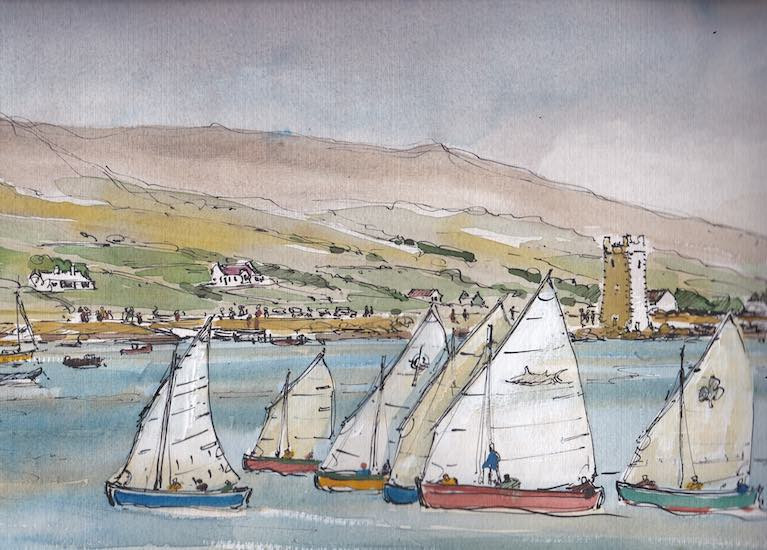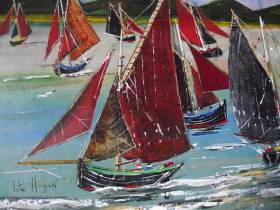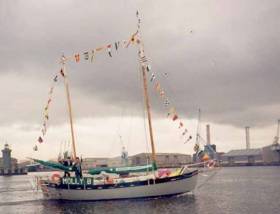Displaying items by tag: Pete Hogan
Discovering the Six Metre 'Southern Cross' Painting by John Ryan
Pete Hogan on receiving a painting by John Ryan that depicts Ryan's boat from the artist's book "A Wave of the Sea"
A friend recently arrived at my place and presented me with a nice picture of a sailing boat. 'Here you are,' he said. 'You might like this'.
Signed simply 'Ryan' I recognised immediately that it was a painting by Dubliner John Ryan (1925 – 1992). It's of a yacht running under a spinnaker through Dalkey Sound. The Muglins and Howth Head are in the background. The yacht looked a bit like a Dublin Bay 24 with its small raised doghouse and big mainsail. Then I noticed the number on the sail - 6, followed then a K27. It didn't take me long to deduce that it was a 6 Metre and of UK registration – the K27.
I was delighted with the painting and embarked upon a bit of further research.
John Ryan will be familiar to many as a central figure in the Dublin literary scene of the immediate post-war years. Ryan was the publisher of Envoy Magazine, which first featured stories by Behan and Dunleavy. He owned the Baily Pub, was a friend of Patrick Kavanagh and was a Joycean enthusiast when it was neither popular nor profitable. In this regard, he had been instrumental in opening the Joyce Museum in the Sandycove Martello tower and saved the door of Bloom's house at 7 Eccles St. when the house was demolished. He is famously credited with establishing Bloomsday as a celebration of Irish literary traditions.
John Ryan had written two books - 'Remembering How we Stood' (still in print) and 'A Wave of the Sea'. With the latter book, I struck gold. On the title page, there is a drawing of the same 6-metre yacht K 27, in the same pose as the painting I had just been given. I quickly realised I had John Ryan's picture of his boat, Southern Cross. The book, A Wave of the Sea, is mainly about his sailing exploits in this boat.
 The front piece of Ryan's Book A Wave of the Sea
The front piece of Ryan's Book A Wave of the Sea
 Illustration from Ryan's book
Illustration from Ryan's book
 Southern Cross
Southern Cross
Southern Cross had been built in 1928 as a racing 6 metre and competed in the Olympics of 1936. Her records are still on the excellent 6 Metre Class website (6metre.com). By 1948 when she retired from racing, she was converted to cruising with the addition of a cabin. This was a common fate for both six and 8-metre yachts as they made handy cruisers in those days before the event of fibreglass boats. Up to six 6 metres in Dun Laoghaire in the 1960's racing in the top cruiser class. (I remember in particular Rainbow 2 excellently sailed by Launce Mc Mullen).
John Ryan does not seem to have raced Southern Cross much but enjoyed cruising with his favourite crew, 'the Briar', who he befriended in one of the Dun Laoghaire bars. The Briar comes across as a nautical equivalent of Ryan's other bawdy friend, Brendan Behan. Together they cruised and caroused the length and breadth of the Irish Sea, around Ireland and many English ports.
John Ryan contributed to the radio programme Sunday Miscellany frequently on marine subjects. He took a keen interest in the Spanish Armada.
The painting of the Southern Cross is quite typical of Ryan's output. He took a lot of care to get the nautical details correct. I was surprised by the complex three-spreader rig on the mast but realised it is probably correct on an old racing six mast. The pre-Dacron mainsail is multi-panelled as the old cotton sails were. What looks like a female crew on the foredeck is attending to the spinnaker, something which is absent from the drawing in the book. The sky is well-painted and dramatic. There is a yacht in the middle distance beating to windward.
Perhaps it is a race, as both yachts sport the old square racing flags. Racing flags were de rigour in the old days. They were square and indicated to other yachts the fact that one was racing and they should get the hell out of the way. Interestingly, the Southern Cross is sporting a burgee, a triangular flag, of indeterminate identity in the book drawing. Also in the distance is a passenger ferry that could be one of the old Isle of Man steam packet ships operated from 1946 to 1982. A fleet of racing sails in the far distance and some seabirds complete the detail. Quite a busy picture.
 A female crew on the foredeck is attending to the spinnaker
A female crew on the foredeck is attending to the spinnaker
A female crew on the foredeck is attending to the spinnaker
 The yacht looked a bit like a Dublin Bay 24 with its small raised doghouse and big mainsail
The yacht looked a bit like a Dublin Bay 24 with its small raised doghouse and big mainsail
There are a few paintings by John Ryan on the internet, usually from auction room catalogues.
I am attempting to write an appreciation of John Ryan as a marine painter, which hopefully would be published in a learned journal.
I would be grateful if anyone out there could send me details of his paintings that they might have or know the location of. There is a very fine example in the National Yacht Club. The OPW is supposed to have one, but I cannot track it down. He exhibited over a long career in the RHA and other exhibitions, including ROSC. Perhaps some curious art student might try and assemble a catalogue raisonné of his work.
Pete Hogan. [email protected]
(With thanks to David Pearson and Colin Mc Mullen).
 Detail of the Ryan painting in the National Yacht Club, Dun Laoghaire
Detail of the Ryan painting in the National Yacht Club, Dun Laoghaire
Dublin Maritime Artist Pete Hogan's 'Open Studio 22' Features Popular Sailing Paintings This Thursday
Maritime artist and round the world sailor, Pete Hogan is inviting you to an 'Open Studio' of his latest works on Thursday, December 8th, on the south shore of Dublin Bay.
Hogan, who sailed solo worldwide in his gaff ketch Molly B in the mid-90s, hosts his 'Open Studio' at his Sandymount home.
Hogan's popular sailing paintings include all manner of craft, along with his latest work entitled 'Serenade'.
 Galway Hookers and other traditional sailing craft feature in Pete Hogan's Open Studio 22 collection
Galway Hookers and other traditional sailing craft feature in Pete Hogan's Open Studio 22 collection
Galway Hookers and other traditional sailing craft also feature on Thursday, along with kitesurfers and some gulls-eye studies of his local waters of Dublin Bay.
 A view by artist Pete Hogan of Dun Laoghaire Harbour and Dublin Bay with Dublin Port, the River Liffey Bull Island and Howth peninsula in the background
A view by artist Pete Hogan of Dun Laoghaire Harbour and Dublin Bay with Dublin Port, the River Liffey Bull Island and Howth peninsula in the background
Hogan, a regular contributor to Afloat about sailing, wrote recently about Achill on the west coast of Ireland, which was illustrated with watercolour drawings of his circumnavigation of Achillbeg.
 Rounding the Fastnet Rock by Pete Hogan
Rounding the Fastnet Rock by Pete Hogan
The Open Studio is on Thursday, December 8th, 2022, at 153 Strand Road, Sandymount, D4. From 6 PM to 9 PM. Children welcome, refreshments and music.
 Kitesurfers on Dublin Bay by Pete Hogan
Kitesurfers on Dublin Bay by Pete Hogan
More details on www.phogan.com
Maritime Artist Pete Hogan Hosts 'Open Art Studio' By Zoom Tonight
Maritime artist and round the world sailor, Pete Hogan is inviting you to a virtual Open Studio tonight in Dublin by Zoom at 8 pm.
Hogan's popular sailing paintings include all manner of craft including works entitled 'Red Sails' that feature Galway Hookers and other traditional sailing craft.
Earlier this month, Hogan wrote in Afloat about sailing in Achill that was illustrated with watercolour drawings of his circumnavigation of Achillbeg.
Hogan, who sailed solo around the world in his gaff ketch Molly B in the mid-90s, hosts his Open Studio via Zoom and details are below:
To Join the Zoom Meeting:
https://us02web.zoom.us/j/81255117713?pwd=c1NZUXIrRWJpalFkaGpHeUxH
Meeting ID: 812 5511 7713
Passcode: 835465
Dublin Bay-based lone circumnavigator and maritime artist Pete Hogan will exhibit his latest works in his 'Open Studio' next Thursday, December 11th.
The works entitled 'Red Sails' form part of the display and feature Galway Hookers and other traditional sailing craft as depicted above and below.
Hogan, who sailed solo around the world in his gaff ketch Molly B in the mid-90s, hosts his Open Studio at 153 Strand Road, Sandymount, Dublin 4. from 6 pm to 9 pm.
Children welcome, refreshments and music on the night. More details on mobile phone: 087 930 9559 and email: [email protected]
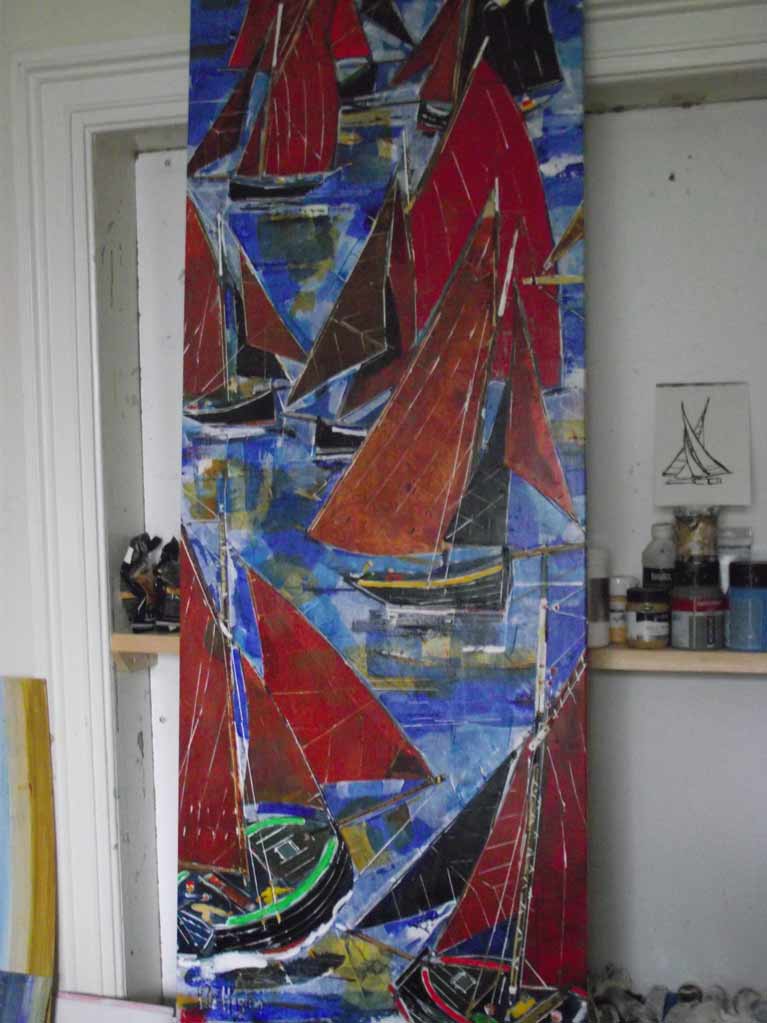 Red Sails by Pete Hogan
Red Sails by Pete Hogan
All Sailors Will Enjoy 'The Mercy' Sailing Movie, Says Pete Hogan
Dublin artist and round–the–world solo sailor Pete Hogan reviews The Mercy, the sailing movie starring Colin Firth and Rachel Weisz that is to be released in Ireland on Friday.
I was invited to the premier of this movie in the Lighthouse cinema in Dublin.
Many sailors will be familiar with the famous case of Donald Crowhurst, the tragic participant in the original Golden Globe race organised by The Sunday Times in 1968 and which Robin Knox Johnston won and thereby made his name.
Crowhurst, having first faked his progress in the race, is generally accepted to have killed himself by jumping overboard. It is a story which refuses to go away having inspired several books, documentaries, plays, poetry and now a reasonably big budget movie. Almost like the Flying Dutchman, the search for Franklin or the tale of Ulysses it has seeped into the lore of the sea.
The movie, starring Colin Firth and Rachel Weisz is a well-constructed affair. The nautical detail is good and includes the construction of an accurate replica of the 40’ tri he used in the race. It’s a lot better than many depictions of nautical matters by Hollywood. The movie follows closely the accepted narrative described in the original book by Tomlinson and Hall published in 1970. (The Strange Last Voyage of Donald Crowhurst). There is little doubt as to the facts of the tragedy. Crowhurst purposely and pointedly left all his writings and charts for others to find - like a lengthy, gruesome suicide note.
The period detail is well done except for the corny London Boat show. It well illustrates the difference between yottin then and now. The hack journalist who promotes Crowhurst almost steals the show. Crowhurst comes across as a model, well adjusted, family man with a beautiful wife and three adorable cute children. Consequently it is less easy to explain how it all went so horribly wrong. Colin Firth makes a good attempt at portraying the mental disintegration of the lone sailor as pressure mounts and failure becomes more apparently inevitable. The boat looks appropriately shambolic and weathers well as the voyage progresses. Firth looks a bit too handsome towards the end rather than the demented tragic figure he must have been. When he hacks at his hair with a nautical knife he looks as if he has just visited Peter Mark.
Calm beautiful wife Rachel Weisz, does most to explain what went wrong. As she slams the door on the baying pack of media reporters, she declares ‘ You are all to blame, every one of you. You pushed him overboard’.
Happily we are spared the actual sight of Crowhurst’s end. Instead we follow into the depths his chronometer which he is believed to have clutched as he jumped off the stern onto the astral plane. This is not really a date movie but it is a brave one in that there was never ever going to be a happy ending.
This is a movie which all sailors will enjoy, especially those who lived through those pioneering heady days of the early OSTAR races and the Sunday Times Golden Globe race of 1968.
Postcript
At the premiere reception I was introduced to Gregor McGuckin who intends to take part in this year’s Golden Globe Race which is being held to commemorate the original one in which Crowhurst took part 50 years ago. Like Donald Crowhurst, Gregor obviously has a dream. But he seems much better grounded, balanced and prepared. I wish him good luck.
Dublin Bay Glen Sailor Pete Hogan will give an illustrated talk tomorrow evening in Lough Derg Yacht Club, County Tipperary on ‘The Log of the Molly B’.
Hogan sailed the self–built 30' gaff rigged ketch solo round–the–world, one of only a few Irishmen to complete the global circumnavigation.
On a subsequent voyage he lost the yacht in a storm in the Med.
Pete Hogan Gives a History of Irish Marine Paintings at the DMYC
Irish Marine Artist Pete Hogan will give a personal history of marine painting in Ireland with an emphasis, he says, on 'yots'.
The Round the world sailor, artist and author will speak at the Dun Laoghaire Motor Yacht Club on the West Pier this Thursday, February 2nd 2017 at 8pm.
Entry is free and all are welcome.
Enda O'Coineen Will Not Be First Irish Solo Circumnavigator
The current Vendee Globe Race non-stop round the world is deservedly attracting enough attention without having to make over-stated claims on behalf of some of its participants writes W M Nixon.
The official website is today carrying a story that if Enda O’Coineen can succeed in his plan of sailing his dismasted IMOCA 60 Kilcullen Voyager from Dunedin at the south end of New Zealand under jury rig to Auckland 800 miles away to the north, where a loaned replacement masts awaits, then if he can continue the voyage back to les Sables d’Olonne round Cape Horn he will become the first Irishman to sail solo round the world.
Not so. Noted Dublin marine artist Pete Hogan, who sailed solo round the world in his gaff ketch Molly B, said today that the number of misapprehensions about who was first doing what in the Irish circumnavigation stakes is astonishing.
For instance, when he rounded Cape Horn in the 1990s, he was acclaimed as the first Irishman to do it alone, for of course Conor O’Brien had done it with the crewed Saoirse in 1925. Yet Pete Hogan found it very difficult to get anyone to listen when he subsequently tried to set the record by saying that Bill King of Galway with the junk-rigged ketch Galway Blazer was the first solo, and that was way back in 1973.
The fact that Bill King was a distinguished former British submarine commander may have projected the image of being non-Irish. But in fact he flew both the Irish tricolour and the
British red ensign, and his home was Oranmore Castle at the head of Galway Bay.
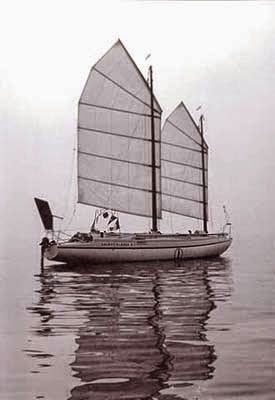 Bill King’s purpose-designed Galway Blazer circumnavigated the world solo south of the great Capes in 1973.
Bill King’s purpose-designed Galway Blazer circumnavigated the world solo south of the great Capes in 1973.
Since then, other Irish sailors who have striven to circumnavigate include Declan Mackell, originally from Portaferry but Canadian-based by the time he undertook his voyage in a Contessa 32, with which he returned home to Ireland for a prolonged stay during his circuit.
Another lone circumnavigator, Pat Lawless of Limerick who completed his voyage with a Seadog ketch in 1996 at the age of 70, had hoped to take in Cape Horn, but rigging damage forced him into a Chilean port, and eventually he returned to Ireland via the Panama Canal. But his circuit was definitely completed, and completed alone.
And Pete Hogan believes there may be one or two other Irish lone circumnavigators who have done it without fanfare. For not everyone seeks the kind of publicity which the Vendee Globe inevitably provides.
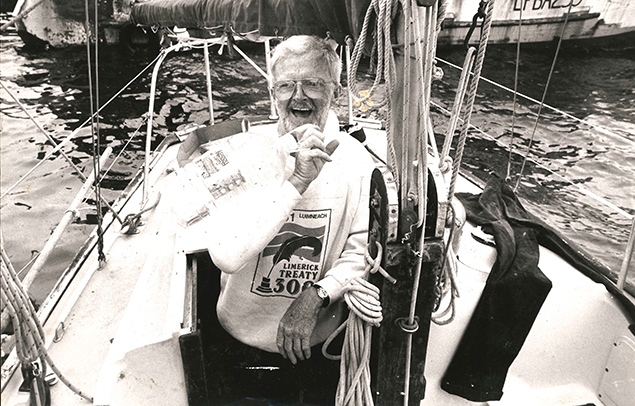 Limerick circumnavigator – the irrepressible Pat Lawless aboard his world-girdling Seadog ketch
Limerick circumnavigator – the irrepressible Pat Lawless aboard his world-girdling Seadog ketch
Thirtieth Anniversary ARC Ready For Atlantic Adventure & Captured in Water Colours
The 30th anniversary edition of the ARC sets out on Sunday, 22nd November. Irish sailor and artist Pete Hogan spent a few days in Las Palmas as the fleet was assembling before departure to Saint Lucia in the East Caribbean. Here he describes the fleet in words and watercolours.
The ARC, the Atlantic Rally for Cruisers is probably the oldest and best known rally of this type. Started in 1985 by Jimmy Cornell, that dynamo of offshore cruising promotion, it was an event which was forming naturally anyway. Many cruising boats were sailing across the Atlantic at that time of year and so an organisation of them was a natural progression.
Cornell sold the ARC concept a few years back, apparently, (and started a rival rally called Odyssey). The Arc is now run by an operation called World Cruising Club which runs cruising rallies all over the world.
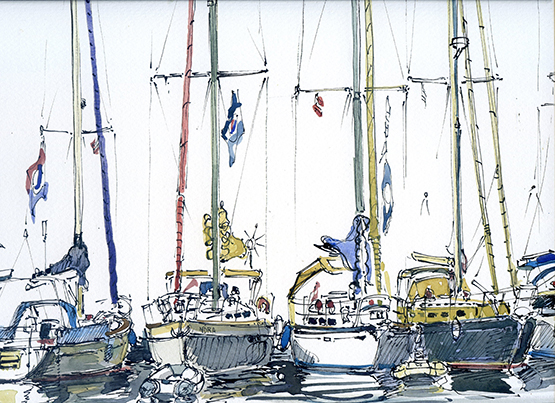
forty footers
Las Palmas is very welcoming to the ARC fleet and the event has spawned a vibrant marine and social industry servicing the yachts. The town has a tourist office adjoining the ARC office. The boatyard was full, the marina was full, extensive chandlery operations plied their trade. The Sailors Bar and harbour side restaurants were buzzing. Agents, sailmakers, fix it men, delivery people, courtesy cars rushed purposefully here and there. Flags declaring participation in the ARC and nationality of crew were proudly flown. Impromptu parties and problem solving sessions, seminars and safety inspections, tee shirt sales and car hire were all doing a great trade. And there were still a few weeks to go before blast off.
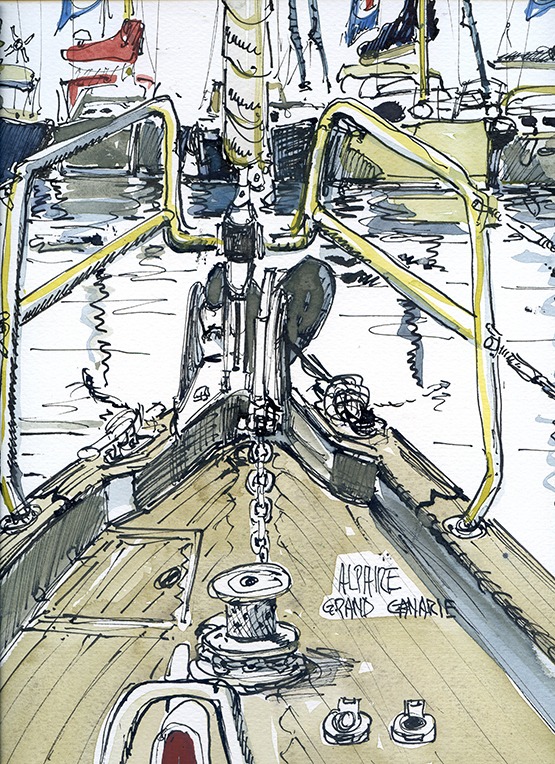
from the bow
Looking at the participants there is a fine mix of nations with three Irish boats listed this year. In addition I met Liam Kavanagh from Tipperary with his girlfriend on their Welsh 40 footer living the dream and there were several other Irish crew in evidence. There is a huge contingent from Scandinavia with the Swedish flag all over the place. Notable by their absence are the French with only 10 entries, a low number for this fanatical sailing nation.
There is a minimum size indicator from the organisers of 27 ft. but in reality the average size of entry is much longer, perhaps 45 ft. The smallest entry I could find this year was a redoubtable Contessa 32.
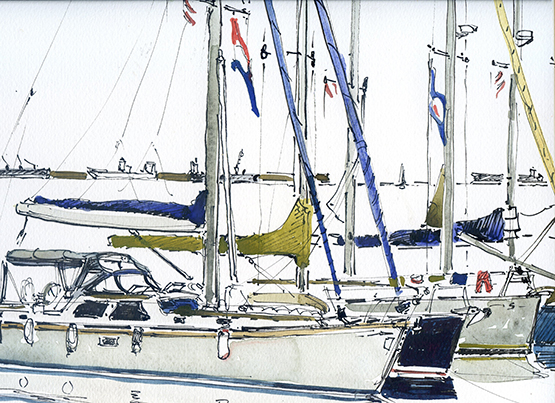
fifty footers
The size, quality and style of the typical ARC participant is indicative of the nature of the ARC nowadays. A typical entry is big, has a centre cockpit, full furling sails (usually electric), water maker and extensive battery of electronics, refrigeration and safety equipment. Electric auto pilots seem to have superseded the magic self-steering vanes, I was sad to note.
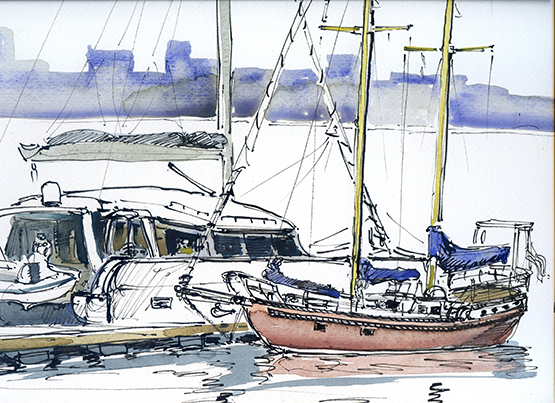
Schooner and cat
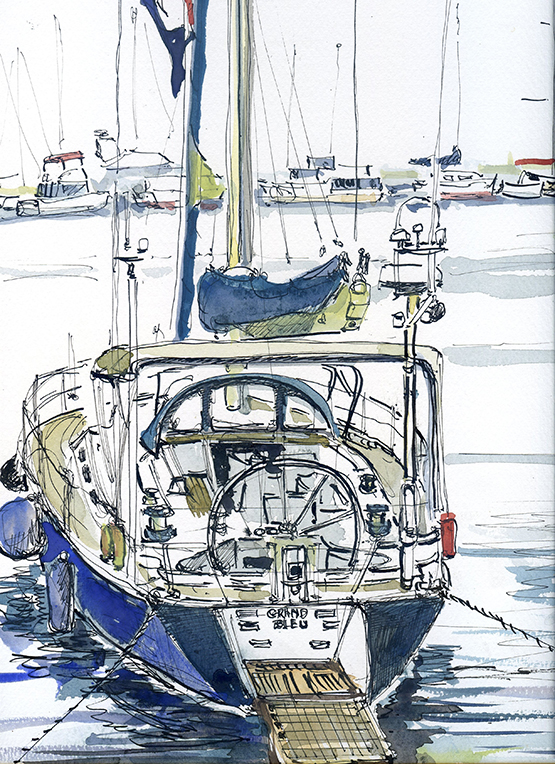
Grand Bleu
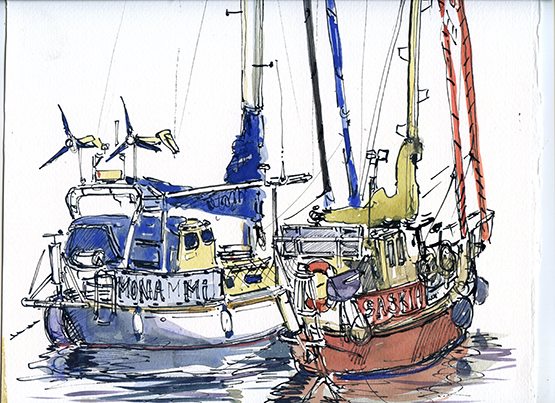
Hard Men
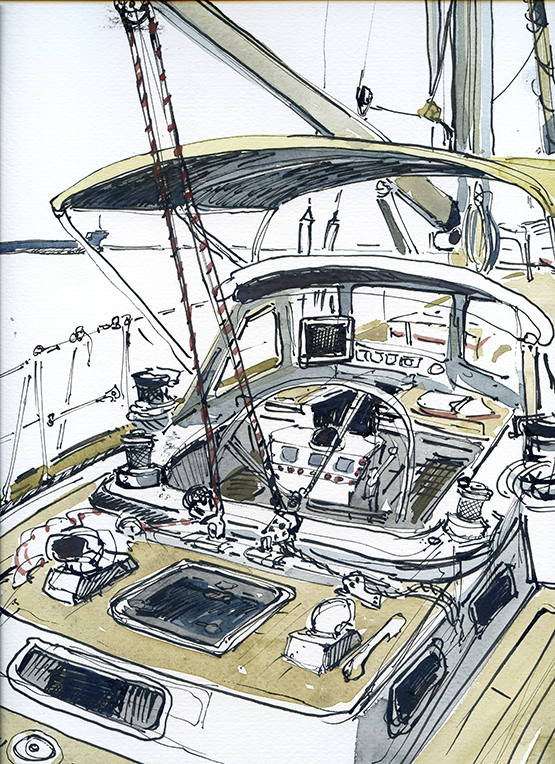
HR 48
There is a huge multihull division with in excess of 35 boats. And all of these would be 50 foot type cats, mainly Lagoon brand. I’m not a fan of these big boxy boats.
Of course you do not have to be in the ARC to sail across the Atlantic on the milk run. The anchorage at Las Palmas was full of the more normal mix of world cruising fleet. As the ARC website says; ‘Most people join a World Cruising Club rally for the security and peace of mind of an organised event; for the camaraderie and friendship of a large group of like-minded people; and for the fun of sailing in a fleet of boats. It’s as much fun for experienced sailors as for those new to ocean sailing.’
Bon Voyage to the participants in the ARC 2015.




























